Your cart is currently empty!
Golden Hour in Motion: The Timeless Beauty of Grand Central Terminal
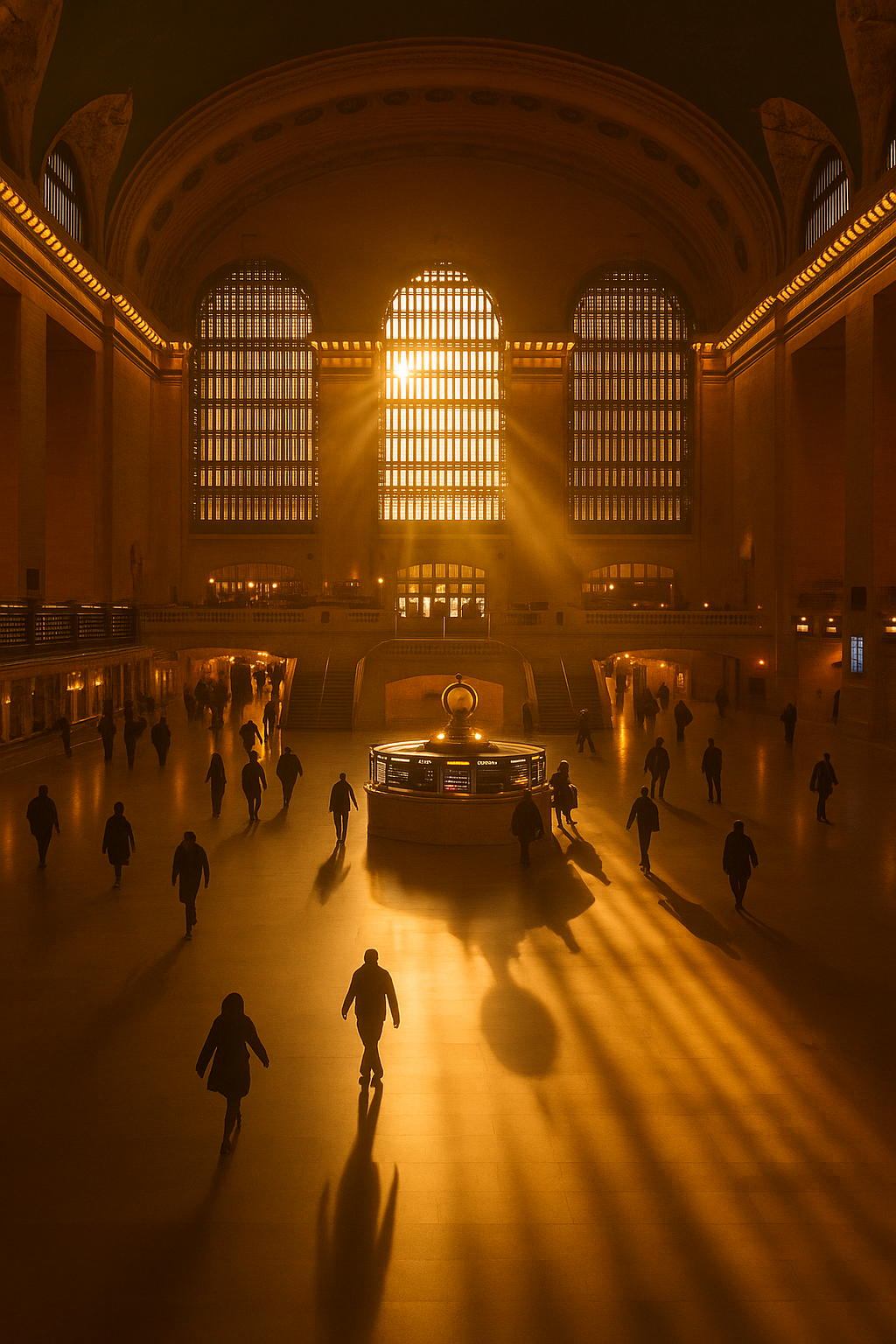
There are moments in New York City when time seems to pause — fleeting instants when light, space, and movement align to create something extraordinary. The image before you captures one such moment inside Grand Central Terminal, that majestic temple of motion and memory at the heart of Manhattan.
Golden sunlight floods through towering arched windows, cutting across the vast concourse in luminous beams. Dust particles shimmer like tiny stars suspended in air. Shadows stretch long and elegant across the marble floor, tracing the quiet rhythm of human movement — travelers, commuters, dreamers all passing through, unaware of how beautifully the light has chosen to frame them.
This isn’t just a photograph of a train station. It’s a portrait of a city’s soul — one that moves endlessly forward, yet somehow finds grace in the in-between.
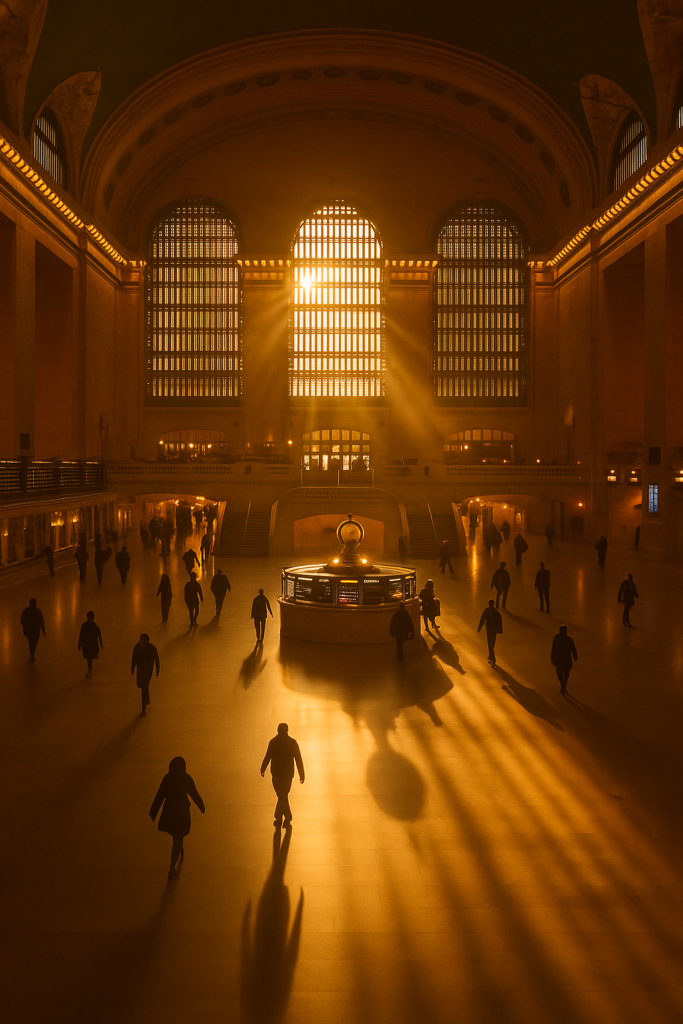
A Cathedral for Commuters
Grand Central Terminal is often called the cathedral of transportation, and for good reason. When it opened in 1913, it wasn’t merely a hub for trains — it was a vision of what progress could look like when infused with art. Every arch, every marble surface, every curve of the ceiling was designed to inspire awe.
In the early 20th century, rail was more than travel — it was adventure, ambition, and connection. New York, the beating heart of modern America, deserved a gateway that felt both monumental and human. The architects, Reed & Stem and Warren & Wetmore, created exactly that: a masterpiece of Beaux-Arts design where engineering and emotion coexist.
Look at the image again. The grand windows stretch upward like stained glass in a cathedral. The light pours through not as decoration but as revelation. Commuters walking beneath those beams resemble pilgrims — not in a religious sense, but in the quiet reverence of people moving through something larger than themselves.
Here, even the ordinary becomes sacred. A man checking his watch, a woman walking briskly to her train, a couple pausing by the information booth — all bathed in the same golden light, all part of the same living artwork.
Light as Time’s Companion
Every photographer who has stood inside Grand Central knows this truth: the light is everything.
The terminal’s famous windows face east, so each morning, sunlight streams through in perfect alignment with the cavernous hall. The effect is pure magic — a celestial performance staged daily for anyone who happens to look up.
In this photo, the sun is low — perhaps early morning or late afternoon — when its rays stretch longest, turning the air into liquid gold. The beams are tangible, like ribbons of light weaving between people. They create both intimacy and grandeur: the space feels infinite, yet every figure feels seen.
Light, in Grand Central, doesn’t just illuminate; it narrates. It traces time, softens stone, and reveals the human scale of this monumental place. It’s as if the building itself breathes with the rhythm of the day — awakening with dawn, glowing at noon, and resting at dusk.
There’s something deeply human in that.
The Heartbeat of New York
Step into Grand Central at any hour, and you feel the city’s pulse. The constant movement, the echo of footsteps, the low hum of conversation, the rhythmic voice over the loudspeakers announcing departures — it’s the soundtrack of New York in motion.
And yet, in this photograph, there’s calm. The light transforms bustle into ballet. People glide through the frame rather than rush. The shadows elongate their forms, turning commuters into silhouettes that feel both anonymous and eternal.
That’s the paradox of Grand Central — it’s chaotic and serene at once. It’s where millions pass without noticing, yet each person adds something to its living story. The architecture absorbs human movement like a great heart — pumping trains, time, and emotion through its marble veins.
Every day, about 750,000 people pass through this hall. Yet somehow, even in that sea of motion, moments like this emerge — when stillness and beauty overtake speed.
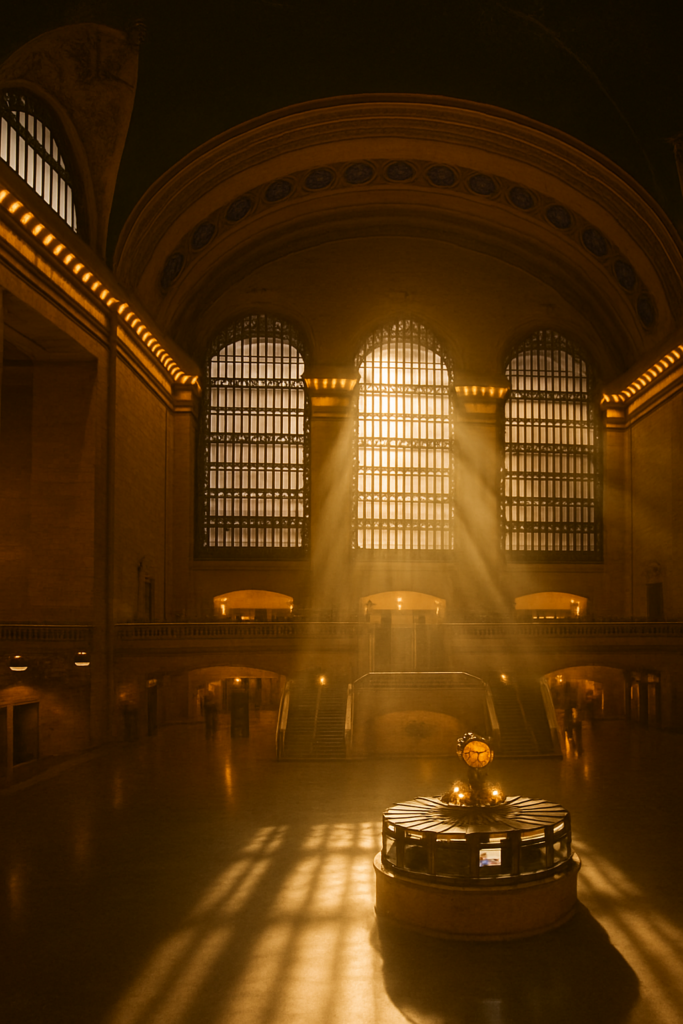
Architecture That Breathes
Grand Central is a study in harmony. The soaring arches, the celestial ceiling mural, the grand staircase, and the clock at the center — all arranged with mathematical precision and artistic intuition.
But beyond symmetry lies soul. The architects understood that a space designed for people should also move them emotionally. The ceiling’s zodiac constellations remind travelers to look up, to dream. The gold and opal clock at the information booth stands as both timekeeper and symbol — a meeting point, a legend, a promise.
In this photo, the clock glows softly, the light wrapping it in warmth. Around it, people gather — some asking for directions, some simply pausing. Above them, the sunlight cascades down, merging with the building’s natural rhythm. The design of Grand Central doesn’t resist time; it invites it in.
Everything — from the limestone walls to the Tennessee marble floors — was built to last not just physically, but emotionally. That’s why, over a century later, Grand Central remains not just functional, but profoundly beautiful.
The Alchemy of Motion and Memory
There’s something almost cinematic about this scene. The combination of architecture, light, and movement evokes both nostalgia and timelessness. You can almost imagine the echo of past decades within these walls — the 1920s jazz age commuters in fedoras, the wartime soldiers embracing loved ones, the quiet moments of waiting that have played out here a million times.
In many ways, Grand Central is a memory machine. Every person who has ever crossed its floor has left an invisible imprint — a trace of emotion that lingers in the air. When sunlight floods in, it illuminates not just the present, but the ghosts of all those yesterdays.
The photograph captures that layering of time — the golden hue feels almost sepia, like a memory you can step inside. It’s both now and forever ago.
That’s what makes Grand Central so deeply cinematic: it is a stage, a setting, a living archive of human passage. Directors from Hitchcock to Nolan have used it not just for its grandeur, but for its symbolism — a place where fate, chance, and time converge.
A Moment Between Worlds
The beauty of this image lies in its transience. The light will move. The shadows will shift. The people will go their separate ways. Yet for one second, everything aligns — architecture, sunlight, humanity — and becomes perfection.
That’s the essence of New York itself. A city of constant motion where meaning hides in fleeting instants. You catch a reflection in a window, a melody from a street musician, a stranger’s smile on the subway — and for a heartbeat, the world feels whole.
This photograph freezes that feeling inside Grand Central. It reminds us that even in a place built for departure, there is presence. Even in a space meant for movement, there is stillness.
The rays of sunlight across the concourse don’t just illuminate people — they connect them. They remind us that every path, every journey, begins from the same shared light.
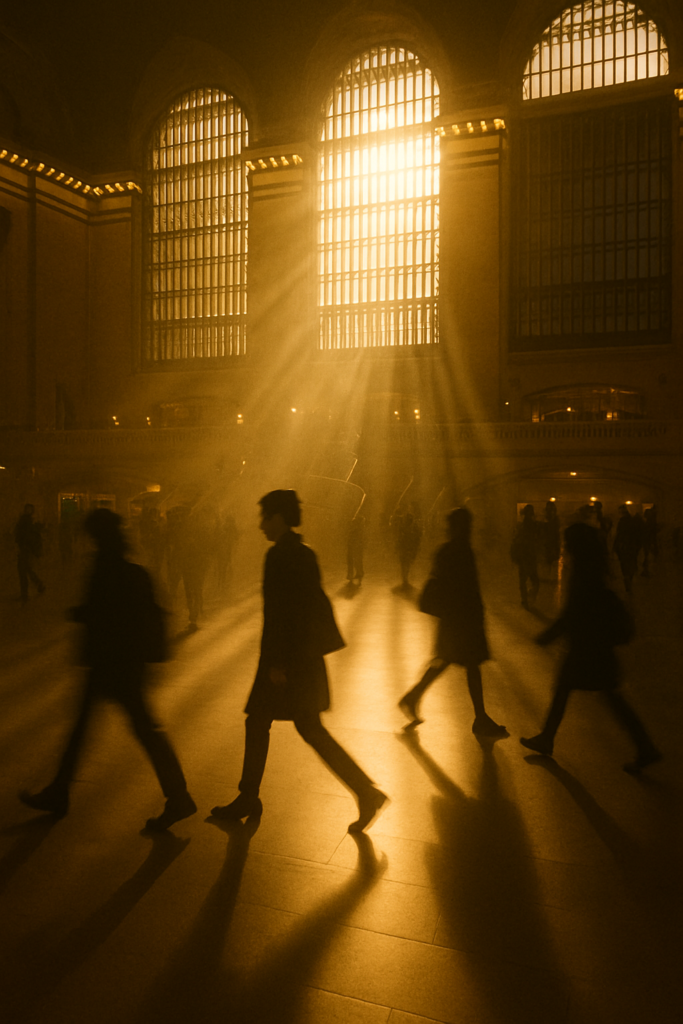
The Clock at the Center of Everything
No image of Grand Central feels complete without the clock — the golden heart of the terminal. Crafted from opal glass and valued in the millions, it has stood in the same spot for over a century. It has witnessed countless goodbyes, reunions, and missed connections.
In this photo, the clock glows softly in the golden light, anchoring the composition like a sun within the sunbeams. Around it, the shadows and movement revolve naturally, like planets around a star.
It’s more than an architectural centerpiece — it’s a symbol of time itself, of the way we measure life in moments rather than minutes. People have arranged to meet “under the clock” for generations — lovers, friends, strangers. In a city that changes constantly, that phrase remains the same.
Perhaps that’s why this scene feels eternal — it’s not about travel or trains, but about connection. The clock is both literal and emotional timekeeper, holding the rhythm of the city’s heart.
Light as a Storyteller
Photography is, at its essence, the art of light. In this image, light tells a story words cannot. It reveals the grandeur of space, the intimacy of detail, and the humanity within scale.
Notice how the beams don’t fall evenly. They curve and stretch, shaping the floor into a canvas of gold and shadow. The patterns echo the movement of the people below — unique yet unified, fleeting yet continuous.
Light transforms the ordinary into the sublime. The same marble, the same clock, the same crowd — but in this moment, under this glow, they become transcendent.
It’s a reminder that beauty often depends not on what we see, but when we see it. The photographer caught Grand Central at its perfect hour — when the sunlight enters like a blessing.
The Soul of a City
There’s a reason Grand Central Terminal continues to draw artists, travelers, and dreamers alike. It represents New York’s dual nature: relentless energy and quiet reflection. It’s both a machine and a monument, a place of motion and memory.
The photo captures this contradiction beautifully. People move, but not in chaos. Light floods in, but softly. The vastness of the hall doesn’t overwhelm; it embraces.
For New Yorkers, Grand Central isn’t just a landmark — it’s part of life’s rhythm. It’s the morning commute, the weekend escape, the first date, the final goodbye. It’s where journeys begin and stories overlap.
For travelers, it’s an introduction to the city’s soul — that blend of architecture, humanity, and light that defines New York’s magic.
The Timeless Dance of Light and People
When sunlight filters through Grand Central’s great windows, something beyond architecture happens. The air becomes alive. The people, whether they notice or not, become part of an ancient dance — one that repeats every morning, unchanged for more than a century.
The beams move across the floor like clock hands. The commuters follow their paths like constellations in motion. The result is choreography without a choreographer, grace without awareness.
That’s what makes this photograph so captivating. It doesn’t stage beauty — it witnesses it. It reveals that wonder is not rare, only unnoticed.
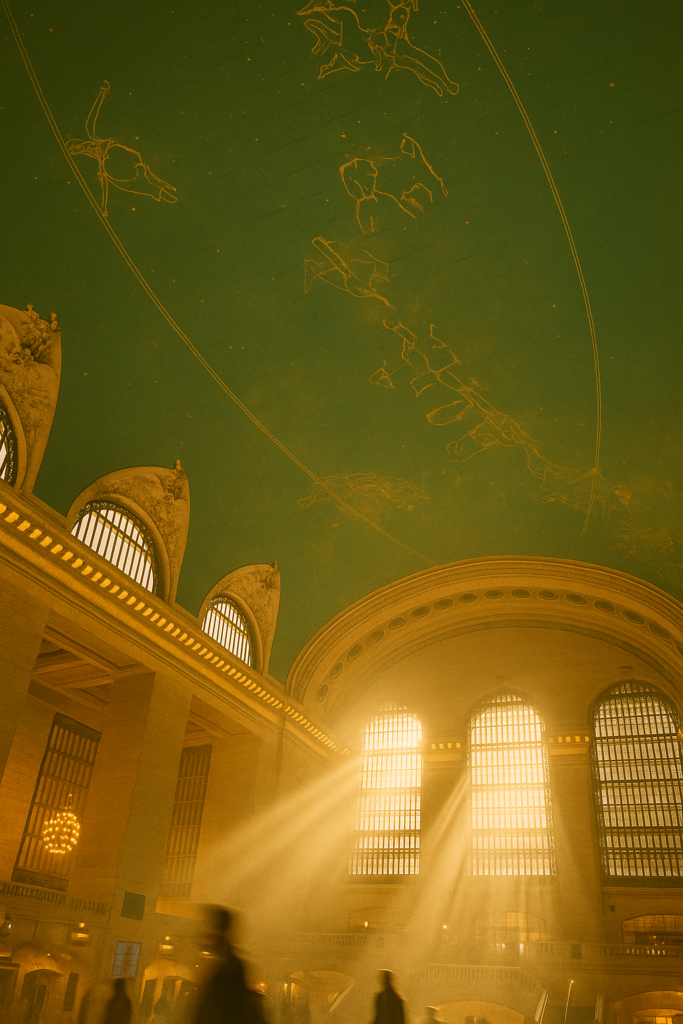
A City That Pauses
In a city famous for speed, Grand Central is a place that invites you to slow down. To look up. To listen. To see how the past and present coexist in light and shadow.
The image does exactly that. It asks nothing more than your attention. The sunlight doesn’t last forever, but while it does, everything seems possible.
Perhaps that’s the deeper message of Grand Central — not that time moves fast, but that beauty exists in motion. You can’t hold the light; you can only stand in it while it lasts.
Conclusion: The Light That Never Leaves
As the sun sinks or rises, its beams retreat from Grand Central’s marble floor. The hall returns to its usual rhythm — footsteps, trains, announcements. But the memory of that light lingers, caught in stone, glass, and human hearts.
The photograph freezes it for us — a golden moment of unity and peace in the world’s most restless city.
In the end, Grand Central Terminal isn’t just a building. It’s a poem written in light and architecture. A living metaphor for movement, connection, and time.
And as long as sunlight finds its way through those arched windows, the city will never lose its glow.
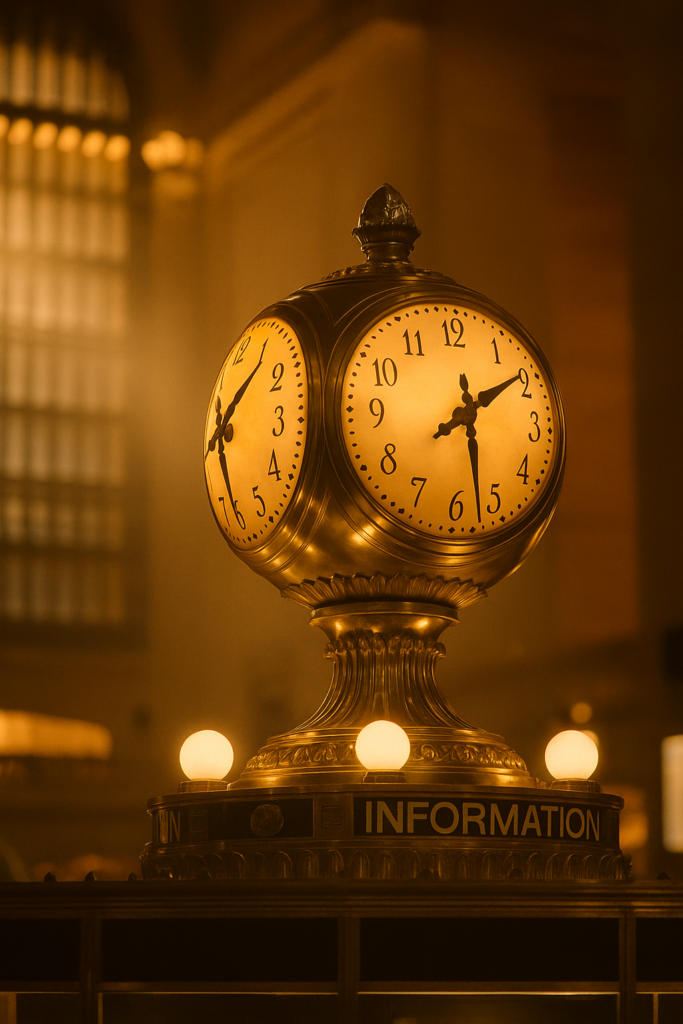

Leave a Reply